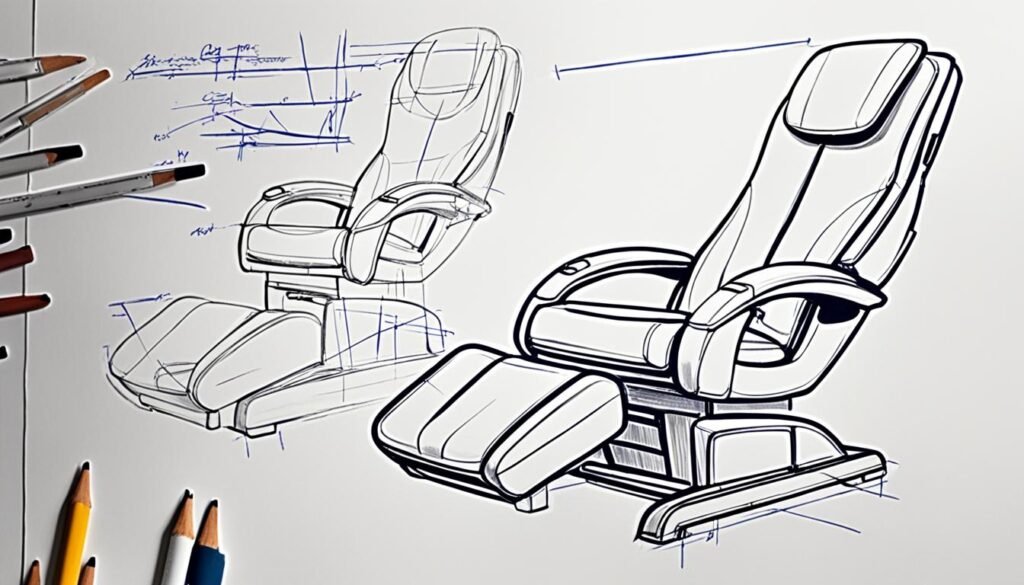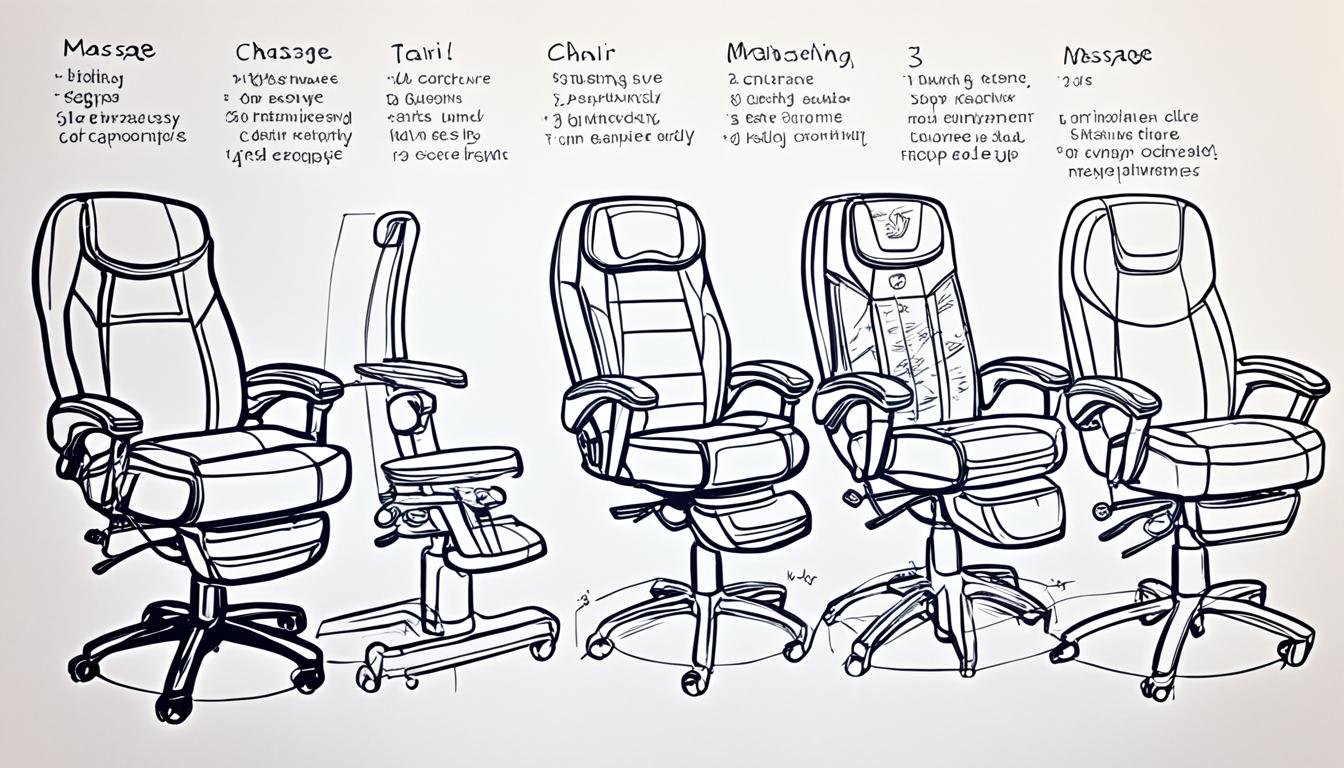Ever thought about drawing a massage chair? It might look hard, but with the right steps, you can draw a beautiful massage chair. This guide will show you how to sketch, improve, and shade a massage chair. You’ll learn to bring your drawing to life.
Key Takeaways:
- Understand the anatomy and design elements of a massage chair
- Gather essential drawing materials and tools
- Create a rough sketch and establish proper proportions
- Refine the sketch by adding details to the backrest, seat, armrests, and leg rest
- Illustrate the mechanical components, such as massage rollers and reclining mechanism
- Add shading, texture, and material details to enhance realism
Introduction to Drawing Massage Chairs
Drawing a massage chair might seem hard, but knowing its parts makes it easier. Before you start drawing, get to know the different parts of a massage chair. These parts work together to make a relaxing massage experience.
Understanding the Anatomy of a Massage Chair
To draw a massage chair well, first learn its basic parts. A massage chair has several key parts, like:
- Backrest: This supports the upper body and has massage rollers for the back muscles.
- Seat: It’s where the user sits and might have airbags or vibration motors for extra comfort.
- Armrests: These support the arms and can have airbags or massage nodes.
- Leg rest: It extends from the chair to support the legs and feet, often with airbags or rollers for a massage.
- Mechanical components: Inside, there are rollers, airbags, and a reclining mechanism for a customized massage.
Importance of Observing and Studying Massage Chair Design
To draw a realistic massage chair, observe and study designs. Look at the proportions, ergonomics, and functionality of different chairs. This helps you capture these elements in your art.
When looking at designs, focus on these points:
| Design Element | Importance |
|---|---|
| Proportions | Make sure the chair’s parts like the backrest, seat, armrests, and leg rest are in the right size and shape for a real look. |
| Ergonomics | Think about how the chair supports the body, with curves and contours for comfort and support. |
| Functionality | See how the chair’s parts like rollers, airbags, and the reclining mechanism work together for a good massage. |
By understanding the anatomy and studying designs, you’ll be ready to draw a detailed and accurate massage chair.
Gathering Essential Drawing Materials
Before you start sketching your massage chair, make sure you have all the drawing tools you need. Pick high-quality drawing paper that is smooth and strong. You can use a sketchbook or individual sheets, depending on what you like.

Then, choose pencils with different grades for various line thicknesses and shading. Start with an HB pencil for basic sketching. Use a 2B pencil for darker lines and a 4B pencil for deep shadows. Also, have a good eraser ready, like a kneaded eraser or a white vinyl eraser, to fix mistakes or refine your drawing.
“The quality of your drawing tools can greatly influence the final result of your massage chair sketch. Invest in high-grade materials to ensure a smooth and enjoyable drawing experience.”
Consider using these extra supplies to improve your sketching:
- Pencil sharpener to keep your lines sharp and precise
- Ruler or straight edge for straight lines and symmetry
- Blending stumps or tortillons for smooth shading and gradients
- Reference images of massage chairs to help guide your drawing
With these materials ready, you’ll be set to draw a detailed and accurate massage chair. Remember, the quality of your supplies can greatly affect your sketch’s final look. So, choose your tools carefully.
Sketching the Basic Outline
Start by drawing a rough sketch of a massage chair. This sketch should show the main features and right proportions. It will help guide your detailed drawing later.
First, look closely at the massage chair and simplify it into basic shapes. The backrest might look like a rectangle, and the seat could be a square or trapezoid. Armrests and leg rests can be simple rectangles or ovals. This makes drawing easier by breaking down the complex chair into simple shapes.
Creating a Rough Sketch of the Massage Chair
Use light, loose lines to sketch the basic shapes of the massage chair. Don’t focus on perfect lines or details yet. Aim for a rough outline that shows the chair’s proportions and perspective.
Think about these key elements as you sketch:
- The height and width of the backrest
- The depth and angle of the seat
- The length and position of the armrests
- The extension and angle of the leg rest
Adjust your sketch to match how these elements fit together. Remember, this is just a rough sketch. Feel free to erase and redraw until you’re happy with the basic outline.
Establishing Proper Proportions and Perspective
Getting the proportions and perspective right is key for a realistic massage chair drawing. Use reference points and guidelines to keep your sketch in check.
Draw a vertical line down the chair’s center for symmetry. Use horizontal lines to set the height of the backrest, seat, and leg rest. These guidelines help keep everything proportionate.
Choose the angle you want to draw the chair from. A front view shows its width and symmetry. A side view highlights its depth and reclining features. A three-quarter view combines elements of both for a dynamic look.
Remember, the key to a successful massage chair sketch is to capture the essential forms and proportions while maintaining a clear perspective. Don’t get bogged down in details at this stage – focus on creating a solid foundation for your drawing.
Refining the Massage Chair Sketch
Now, let’s make your massage chair sketch even better by adding more details. This will make your sketch look more real. Focus on the backrest, seat, armrests, and leg rest to capture their unique features.
Adding Details to the Backrest and Seat
Start by making the backrest and seat look more detailed. Think about the chair’s design and how it supports the body. Add curves to the backrest that match the spine’s shape. Sketch the seat, including any padding for extra comfort.

Sketching the Armrests and Leg Rest
Then, focus on the armrests and leg rest. Notice how they connect to the chair and where they sit on the user. Add curves to the armrests for arm and elbow support. Sketch the leg rest, thinking about how it moves and any extra features like padding.
Keep an eye on the chair’s proportions and balance as you sketch. Make sure everything fits well together. Use light lines to adjust things, then darken them as you get more confident.
“The devil is in the details. A good sketch captures the essence of the subject, but a great sketch brings it to life through the careful rendering of intricate details.” – Anonymous
By refining your sketch and adding these details, you’ll make a more convincing massage chair drawing. This will not only make your drawing better but also show you understand the chair’s design and how it works.
Drawing the Mechanical Components
Now, it’s time to make your massage chair drawing come alive by adding the mechanical parts. These parts are key to making a massage chair work and help with therapy. By drawing the massage rollers, airbags, and reclining mechanism, you’ll make your drawing more realistic.
Illustrating the Massage Rollers and Airbags
Start by drawing the massage rollers in the backrest of the chair. These rollers copy the feel of a massage therapist’s hands, giving a relaxing and refreshing massage. Make sure they match the chair’s size and shape.
Then, draw the airbags in the seat, leg rest, and armrests. These inflate and deflate to give pressure and a compression massage. Think about their position and how they look when they’re filled and empty.
Depicting the Reclining Mechanism
The reclining mechanism is key for a massage chair, letting users adjust the chair for the best comfort and massage. Focus on the hinges, levers, and support structures when drawing this part.
Here are some things to consider when drawing the reclining mechanism:
- The pivot points where the backrest and leg rest meet the chair
- The hydraulic or electric parts that make the chair recline
- The support structures that keep the chair stable and strong when reclined
Tip: Use thin, precise lines for the mechanical parts to keep your drawing clear and detailed.
| Mechanical Component | Location | Function |
|---|---|---|
| Massage Rollers | Backrest | Mimic the movements of a massage therapist’s hands |
| Airbags | Seat, Leg Rest, Armrests | Inflate and deflate to apply pressure and provide compression massage |
| Reclining Mechanism | Connects Backrest and Leg Rest to Main Chair Body | Allows users to adjust the chair’s position for optimal comfort and targeted massage |
By showing the massage rollers, airbags, and reclining mechanism, you’ll add technical detail to your massage chair drawing. This makes your drawing more realistic and interesting.
Shading and Adding Depth
Now, let’s make your massage chair drawing come alive with shading and depth. Shading is key for a realistic and attractive drawing. Highlights and shadows help show the chair’s three-dimensional form, making it look more real.
Start with pencils of different hardness levels, from hard (H) to soft (B). Hard pencils make light, precise lines, while soft pencils create dark, blendable shades. Begin by lightly shading where shadows would naturally fall, like the upholstery folds or the underside of the armrests and leg rest.
As you go on, add more shading with hatching, cross-hatching, and blending. Think about the light source and how it changes the look of the chair’s surfaces and materials. Leather or fabric might have soft, diffused shadows, while plastic and metal have sharp, defined ones.
“The key to effective shading is to work slowly and gradually, building up the depth and dimension layer by layer.” – Art Instructor
Remember to add highlights where light would naturally bounce off the chair. Use an eraser or a kneaded eraser to lift graphite and create lighter areas. This contrast with the shadows makes your drawing more dynamic and realistic.
- Use a variety of shading techniques, such as hatching, cross-hatching, and blending
- Pay attention to the direction of the light source and how it affects shadows and highlights
- Build up shading gradually, working from light to dark
- Use highlights to emphasize areas where light would naturally reflect off surfaces
Mastering shading and depth in your massage chair drawing will give you a striking, realistic piece. Practice these techniques often, and you’ll get better at capturing light and shadow in your drawings.
Incorporating Texture and Material Details
To make your massage chair drawing stand out, focus on texture and material details. Show the different surfaces and parts of the chair to make it look real and appealing. Pay special attention to the upholstery, whether it’s leather or fabric, and the plastic and metal parts.

Representing Leather or Fabric Upholstery
Think about the material you want for the chair’s upholstery. Leather and fabric look different and can be shown with shading and lines.
- For leather, use smooth shading to give it a shiny look. Highlight where it wrinkles or creases, like around seams or where people sit.
- With fabric, use textured shading. Short, varied lines can show the fabric’s weave. Adding a design can make it look more real.
Illustrating the Plastic and Metal Components
A massage chair also has plastic and metal parts that are important for its look and how it works. To draw these parts right, focus on their smooth surfaces and how they reflect light.
- For plastic parts, like the base or control panel, use clean lines to show their smoothness. Add highlights and shadows to make them look three-dimensional and shiny.
- With metal parts, like the frame or levers, use shading that shows how metal reflects light. Mix light and dark tones to make it look polished and real.
Adding these details to your drawing makes it more engaging and true to life. Your art will show the chair’s design details, from the soft upholstery to the strong plastic and metal parts. This will make your drawing stand out, showing your skill and eye for detail.
Finalizing the Massage Chair Drawing
Now, your massage chair drawing is almost done. It’s time to add the final touches and details. Step back and check your illustration for its overall look, making sure everything fits right. Look for spots that need more shading to make the chair look more real.
Focus on making your drawing consistent as you finish it. Make sure the shading is the same everywhere, like on the backrest, seat, and armrests. Clean up any lines or smudges left from sketching. This will make your artwork look neat and professional.
In the last steps of refining your drawing, feel free to make changes or add new details. Adding highlights to the upholstery or making the mechanical parts look better can really improve your illustration. When you’re happy with your work, your massage chair drawing is finished. It’s now ready to be shown off or used for your purpose.
FAQ
What inspired the creation of the first traditional massage chair?
What materials do I need to draw a massage chair?
How do I start sketching a massage chair?
What components should I include when drawing a massage chair?
How can I make my massage chair drawing look more realistic?
What should I do in the final stage of drawing a massage chair?
Source Links
- Sit Down and Draw: Art Resources – https://seatup.com/blog/sit-down-and-draw/
- What is chair massage? Everything you need to know… – https://www.sensemassage.co.uk/resources/hub/85-what-is-chair-massage-everything-you-need-to-know
- Massage Chairs Archives – Furniture For Life – https://furnitureforlife.co.uk/learning-center/category/massage-chairs/













14 Comments
I never thought drawing a massage chair could be so intricate! Who knew there was so much to learn about the anatomy and design of something we use every day? Definitely gained a new appreciation for these comfy chairs.
I never knew drawing a massage chair could be so fascinating! Who wouldve thought there was so much to learn about the anatomy and design of a simple chair? Definitely going to give this a try.
While I appreciate the effort put into this article, I must ask, why are we drawing massage chairs? Isnt it more practical to learn how to draw humans or nature? Just seems like an odd choice to me.
Interesting guide, but why focus on drawing a massage chair? Arent there more compelling subjects like people, nature or abstract ideas? Feels a bit niche, dont you think?
Interesting guide, but isnt it more beneficial to focus on drawing people or nature rather than massage chairs? Just a thought.
Interesting guide, but does studying massage chair design really enhance our drawing skills, or is it a niche skill?
Ever heard of perspective? Studying any design enhances drawing skills. Its not niche, its fundamental.
Interesting read. But, does understanding the anatomy of a massage chair really improve drawing skills? Seems a bit stretched to me.
Interesting guide, but how does understanding the anatomy of a massage chair improve our drawing skills? Isnt practice more important?
Interesting tutorial! But wouldnt it be more beneficial to learn to draw something more common, like a regular chair or a table?
Interesting read! But dont you think understanding the functionality of a massage chair is equally important as its anatomy for drawing?
Interesting read! But how does drawing a massage chair improve our overall sketching skills? Can it help with other complex objects too?
Interesting tutorial, but does understanding the anatomy of a massage chair really influence the drawing quality?
Absolutely! Knowing the anatomy enhances drawing accuracy. Better understanding equals better representation.